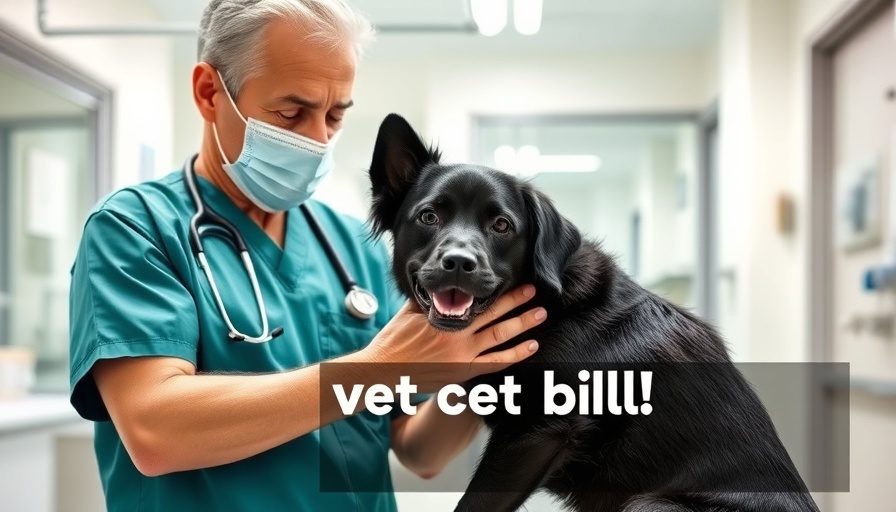
Costs of Veterinary Care: Are They Sustainable?
The increasing burden of veterinary bills has become a pressing reality for pet owners, leading many to reconsider how they approach pet care. According to a recent Gallup study, nearly half of pet parents are avoiding necessary veterinary visits due to the painful costs associated with pet health care. The average yearly expense of taking care of a pet, including basic veterinary services, can range from $2,000 to $5,000, while lifetime costs can soar anywhere between $20,000 to $60,000. With these staggering figures, one must examine whether our affection for our pets can justify the financial strain they impose on our households.
In 'Why Are Vet Bills So High in 2025? Hidden Costs & How to Lower Them,' the discussion dives into the escalating veterinary fees and how pet owners are coping with this reality. We’re breaking down its key ideas and adding our perspective to provide helpful insights.
Pet Owners Navigate Financial Struggles
As reports emerge from pet parents struggling to make ends meet while caring for their beloved companions, the emotional impact of these financial decisions cannot be underestimated. Stories of individuals having to refinance their homes or take out loans just to pay for veterinary care showcase the significant role that money plays in the care we provide for our pets. High-profile cases feature bills totaling tens of thousands due to unexpected health issues, such as an ACL surgery or emergency care for serious conditions like pancreatitis. Such escalated costs can lead owners to question their capacity to continue providing adequate care.
Why Are Veterinary Costs Rising?
Several factors contribute to the increasing costs of veterinary services. The rising salaries of veterinarians and support staff, the demanding expectations pet owners have for high-quality care, and the corporate takeover of local veterinary practices all play crucial roles. Many veterinary clinics are now operated by large corporations focused on maximizing profit, raising fees disproportionately without additional value. This evolution means that long-established pet care practices are now treated as commodities—many vets face pressure to adhere to corporate profit margins at the expense of compassionate, personalized care.
Alternatives: Should You Consider Pet Insurance?
With many owners searching for ways to alleviate the financial stress of pet care, pet insurance can offer a viable solution. Despite the reality that only about 10% of pet owners in North America currently hold insurance, obtaining a policy can provide peace of mind and a financial safety net. Premiums typically average around $50 per month for a young healthy pet without pre-existing conditions, with deductible options ranging broadly. While paying out of pocket for services upfront can be challenging, many owners find reassurance in knowing that they are protected against catastrophic expenses.
Taking Matters into Your Own Hands: Home Remedies
In addition to exploring pet insurance, many pet parents are turning to home remedies as a way to care for their furry friends without incurring exorbitant veterinary bills. From basic examinations to herbal treatments, the growing trend of natural pet care allows pet owners to enhance their pets’ well-being while saving money. Popular options include using antihistamines for acute allergic reactions, employing propolis mouthwash for dental care, and more. Utilizing knowledge from reputable sources can equip pet owners with the tools to manage numerous conditions at home, fostering a closer bond between pet and owner.
Creating Effective Communication with Your Vet
Communication with your veterinarian is vital in these financially sensitive times. Building a rapport can allow pet parents to engage in dialogue about costs openly. Discussing your budget during consultations can lead to tailored recommendations, whether that means opting for fewer diagnostics or exploring payment plans. Community-based practices may even provide a sense of flexibility that corporate practices cannot.
Final Thoughts
In conclusion, as the landscape of veterinary care shifts, pet owners must navigate a delicate balance between providing quality care and managing financial constraints. By being proactive through the pursuit of pet insurance, employing home remedies, and maintaining open communication with veterinarians, pet parents can advocate for both their financial well-being and their pets' health. In a world where our pets are treated like family members, it is essential to ensure we can give them the care they deserve without derailing our financial stability.
As you consider your own pet's health, remember to evaluate all options available to you. Knowledge is power, and you can empower yourself to take charge of your pet's health responsibly and thoughtfully.
 Add Row
Add Row  Add
Add 




Write A Comment